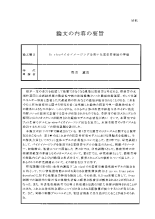In vivoバイオイメージングを用いた筋疲労要因の評価 Evaluation of the muscle fatigue factors using in vivo bio-imaging model
この論文にアクセスする
この論文をさがす
著者
書誌事項
- タイトル
-
In vivoバイオイメージングを用いた筋疲労要因の評価
- タイトル別名
-
Evaluation of the muscle fatigue factors using in vivo bio-imaging model
- 著者名
-
稲垣, 薫克
- 著者別名
-
イナガキ, タダカツ
- 学位授与大学
-
電気通信大学
- 取得学位
-
博士 (理学)
- 学位授与番号
-
甲第623号
- 学位授与年月日
-
2011-03-24
注記・抄録
博士論文
2010
The present study attempted to elucidate skeletal muscle fatigue factorsusing in vivo bio-imaging model of rat skeletal muscle.Skeletal muscle fatigue is characterized by a progressive decline of muscleforce production or power output during and following prolonged orrepeated muscle contractions. Although the mechanisms involved havebeen widely studied, detailed mechanisms are still unclear because ofnumerous factors influenced. Therefore, to clarify the mechanisms ofmuscle fatigue many studies have been performed on isolated wholemuscles or single fibers. However, in vitro study has various limitations.For instance, single fibers do not survive well at physiological temperature,there is no blood circulation and there are no interactions between differentmuscle fiber types, thus there are many differences compared with under invivo conditions. Neural modulation, blood flow, muscular energymetabolism and the intracellular ion dynamics affect muscle fatigue. Tostudy the mechanism of muscle fatigue, the complex in vivo observationmodel is required.The rat spinotrapezius muscle is likened to the human quadriceps femoriswith respect to containing each of the major muscle fiber types and able toobserve under intravital microscopy. Recently, the bio-technology using acombined with a fluorescent substance for a specific ion has remarkablebeen developed. By combining these approaches, the purpose of presentinvestigation was to test the original challenges in the rat spinotrapeziusmuscle during muscle fatigue, and we demonstrated following results.To establish in vivo model of muscle fatigue, various muscle stimulationswere used. 1) Whereas repetitive isometric tetanic contractions inducedby 0.2-ms pulse stimulations did not affect arteriolar diameter or musclefatigability, 4-ms pulse stimulations evoked progressive arteriolarvasoconstrictor response that is blocked by alpha adrenergic receptorantagonists and intimately associated with fatigue process. 2) Repetitiveeccentric contractions maintained passive force production due to elevated[Ca2+]i to a greater extent than isometric contractions. 3) Femalesmaintain force production during repetitive isometric tetanic contractionsdue to [Ca2+]i homeostasis was maintained, and the presence of normalestrogen levels may not obligatory for the gender difference of musclefatigue. 4) Intracellular acidosis may not be a cause of muscle fatiguebecause it was adjusted by monocarboxylic acid transporter that existed onsarcolemma.

